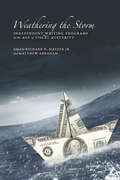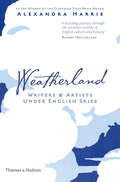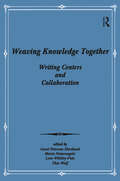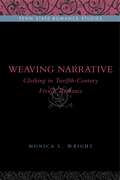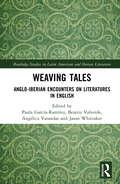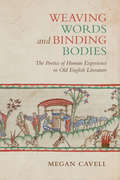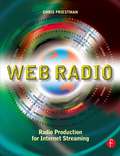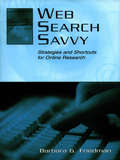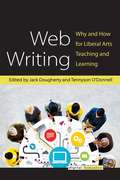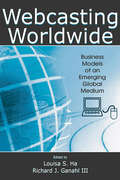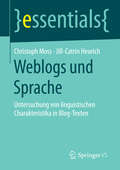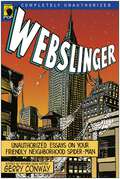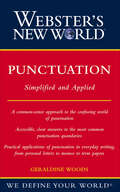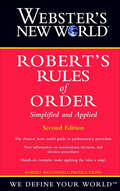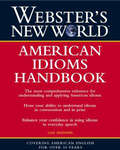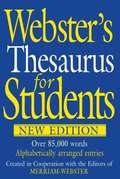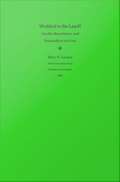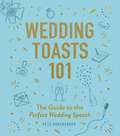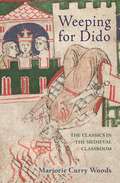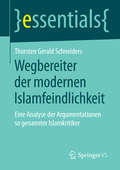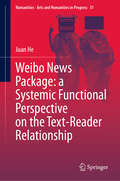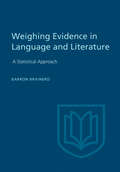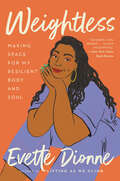- Table View
- List View
Weathering the Storm: Independent Writing Programs in the Age of Fiscal Austerity
by Matthew Abraham Richard N. MatzenWeathering the Storm assesses the socioeconomic and political conditions that have surrounded the rise of independent writing programs (IWPs) and departments. Chapter contributors look at the institutional conditions and challenges that IWPs have faced since the 1980s with a focus on enduring the financial collapse of 2008. Leading writing specialists at the University of Texas at Austin, Syracuse University, the University of Minnesota, and many other institutions document and think carefully about the on-the-ground obstacles that have made the creation of IWPs unique. From institutional naysayers in English departments to skeptical administrators, IWPs and the faculty within them have surmounted not only negative economics but also negative rhetorics. This collection charts the story of this journey as writing faculty continually make the case for the importance of writing in the university curriculum. Independence has, for the most part, allowed IWPs to better respond to the Great Recession, but to do so they have had to define writing studies in relation to other disciplines and departments. Weathering the Storm will be of great interest to faculty and graduate students in rhetoric and composition, writing program administrators, and writing studies and English department faculty. Contributors: Linda Adler-Kassner, Lois Agnew, Alice Batt, David Beard, Davida Charney, Amy Clements, Diane Davis, Frank Gaughan, Heidi Skurat Harris, George H. Jensen, Rodger LeGrand, Drew M. Loewe, Mark Garrett Longaker, Cindy Moore, Peggy O’Neill, Chongwon Park, Louise Wetherbee Phelps, Mary Rist, Valerie Ross, John J Ruszkiewicz, Eileen E. Schell, Madeleine Sorapure, Chris Thaiss, Patrick Wehner, Jamie White-Farnham, Carl Whithaus, Traci A. Zimmerman
Weatherland: Writers & Artists Under English Skies
by Alexandra HarrisA lively look at the English literary and artistic responses to the weather from Chaucer and Shakespeare to Keats and Ian McEwan In a sweeping panorama, Weatherland allows us to witness England’s cultural climates across the centuries. Before the Norman Conquest, Anglo-Saxons living in a wintry world wrote about the coldness of exile or the shelters they had to defend against enemies outside. The Middle Ages brought the warmth of spring; the new lyrics were sung in praise of blossoms and cuckoos. Descriptions of a rainy night are rare before 1700, but by the end of the eighteenth century the Romantics had adopted the squall as a fit subject for their most probing thoughts. The weather is vast and yet we experience it intimately, and Alexandra Harris builds her remarkable story from small evocative details. There is the drawing of a twelfth-century man in February, warming bare toes by the fire. There is the tiny glass left behind from the Frost Fair of 1684, and the Sunspan house in Angmering that embodies the bright ambitions of the 1930s. Harris catches the distinct voices of compelling individuals. “Bloody cold,” says Jonathan Swift in the “slobbery” January of 1713. Percy Shelley wants to become a cloud and John Ruskin wants to bottle one. Weatherland is a celebration of English air and a life story of those who have lived in it.
Weaving Knowledge Together: Writing Centers and Collaboration
by Carol Peterson Haviland; Maria Notarangelo; Lene Whitley-Putz; ThiaWolfFirst published in 1998. In a 1996 review article in College English, Elizabeth Rankin contrasted the method and epistemology of two recent books on writing pedagogy, describing one as "grounded in the experience of student writers and teachers" and the other as "academic." Rankin’s labels highlight one of the leading sources of tension in composition research—the tension between practice and theory—a tension that echoes in writing center research and publications. This collection of chapters seeks to build on the inherent collaborativeness of writing centers, capturing the voices of the student writers and tutors who are at the core of writing center work.
Weaving Narrative: Clothing in Twelfth-Century French Romance (Penn State Romance Studies #10)
by Monica L. WrightEnide’s tattered dress and Erec’s fabulous coronation robe; Yvain’s nudity in the forest, which prevents maidens who know him well clothed from identifying him; Lanval’s fairy-lady parading about in the Arthurian court, scantily dressed, for all to observe: just why is clothing so important in twelfth-century French romance? This interdisciplinary book explores how writers of this era used clothing as a signifier with multiple meanings for many narrative purposes. Clothing figured prominently in twelfth-century France, where exotic fabrics and furs came to define a social elite. Monica Wright shows that representations of clothing are not mere embellishments to the text; they help form the textual weave of the romances in which they appear. This book is about how these descriptions are constructed, what they mean, and how clothing becomes an active part of romance composition—the ways in which writers use it to develop and elaborate character, to advance or stall the plot, and to structure the narrative generally.
Weaving Tales: Anglo-Iberian Encounters on Literatures in English (Routledge Studies in Latin American and Iberian Literature)
by Jason Whittaker Paula García-Ramírez Beatriz Valverde Angélica VarandasThis collection of essays brings together a wide range of Spanish and Portuguese academics and writers exploring the ways in which our encounters with literatures in English inform our assumptions about texts and identities (or texts as identities) and the way we read them. Mapping, examining, reading and re-reading, fashioning and self-fashioning and, especially, weaving appear as appropriate images that convey the complexity and the nature of creative writing. Such a metaphor has been fundamental for the history of world literature since the Roman poet Ovid had included a tale in his Metamorphoses in which weaving, narration, uncertain identities, and the risks of telling uncomfortable truths all figure prominently. As such, these essays trace the intertwined patterns that knit texts together, weaving identities as well as undoing them and, in the process, interrogating established and official truths.
Weaving Words and Binding Bodies: The Poetics of Human Experience in Old English Literature
by Megan CavellReferences to weaving and binding are ubiquitous in Anglo-Saxon literature. Several hundred instances of such imagery occur in the poetic corpus, invoked in connection with objects, people, elemental forces, and complex abstract concepts.Weaving Words and Binding Bodies presents the first comprehensive study of weaving and binding imagery through intertextual analysis and close readings of Beowulf, riddles, the poetry of Cynewulf, and other key texts. Megan Cavell highlights the prominent use of weaving and binding in previously unrecognized formulas, collocations, and type-scenes, shedding light on important tropes such as the lord-retainer "bond" and the gendered role of "peace-weaving" in Anglo-Saxon society. Through the analysis of metrical, rhetorical, and linguistic features and canonical and neglected texts in a wide range of genres, Weaving Words and Binding Bodies makes an important contribution to the ongoing study of Anglo-Saxon poetics.
Web Radio: Radio Production for Internet Streaming
by Chris PriestmanAnyone wanting to set up a low cost web radio station will benefit from the advice and information provided by this book. Not only will you gain technical and practical know-how to enable your station to go live, but also an appreciation of the legal and copyright implications of making radio, potentially for international audiences and in the rapidly evolving environment of the web.To succeed, your radio content will need to be carefully planned and your station properly promoted. Advice is given on taking advantage of the scalability web radio introduces for building audiences in line with your resources, for scheduled live output and for making programmes available on demand, including music, news, speech radio and audience participation. Case studies from around the world are provided to demonstrate how different radio organisations are applying the new flexibility web radio has to offer in a wide range of situations. Together with its associated website www.web-radio-book.com, the book also acts as a starting point for locating a range of sources for further advice and lines of research. Learn how to: - go live with your own low cost web radio station (either managing the server yourself or using a host service) - assess the right server set-up to handle the number of simultaneous listeners expected - get the best sound quality to your listeners- take account of the range of devices available for receiving web radio- plan your station, programming and associated website - identify and reach your audience - build audience feedback and data into your station's strategy- tackle the additional legal and ethical dimensions of radio on the web - source more detailed information
Web Search Savvy: Strategies and Shortcuts for Online Research (Routledge Communication Series)
by Barbara G. FriedmanWeb Search Savvy: Strategies and Shortcuts for Online Research provides readers of all skill levels with efficient search strategies for locating, retrieving, and evaluating information on the Internet. Utilizing her experience as a reporter working on deadline, author Barbara G. Friedman offers the most effective methods for finding useful and trustworthy data online, and presents these techniques in a straightforward, user-friendly manner.Anyone who uses the Internet for research will find much of value here, including techniques that harness the power of advanced searches to optimize search results, avoid advertising clutter, and locate low- or no-cost databases. Screen captures and diagrams illustrate the steps, rationale, and results to accompany various search strategies. This book emphasizes techniques that make the Web work for individuals rather than for advertisers, such as choosing the most appropriate search engine for the job and tweaking its advanced options to narrow a search and optimize results; identifying cost-free sources of online data; using creative approaches to locate information; evaluating the integrity of online data; and protecting the privacy of the researchers and the researched.Web Search Savvy is an essential resource for students, scholars, and practitioners in journalism and mass communications, and it offers practical and useful guidance for anyone researching information online.
Web Writing: Why And How For Liberal Arts Teaching
by Jack Dougherty Tennyson O'DonnellThe essays in "Web Writing" respond to contemporary debates over the proper role of the Internet in higher education, steering a middle course between polarized attitudes that often dominate the conversation. The authors argue for the wise integration of web tools into what the liberal arts does best: writing across the curriculum. All academic disciplines value clear and compelling prose, whether that prose comes in the shape of a persuasive essay, scientific report, or creative expression. The act of writing visually demonstrates how we think in original and critical ways and in ways that are deeper than those that can be taught or assessed by a computer. Furthermore, learning to write well requires engaged readers who encourage and challenge us to revise our muddled first drafts and craft more distinctive and informed points of view. Indeed, a new generation of web-based tools for authoring, annotating, editing, and publishing can dramatically enrich the writing process, but doing so requires liberal arts educators to rethink why and how we teach this skill, and to question those who blindly call for embracing or rejecting technology.
Webcasting Worldwide: Business Models of an Emerging Global Medium (Media Management and Economics Series)
by Louisa HaWebcasting Worldwide tackles one of the most timely topics in mass communication today—the delivery of audio and video content via the Web, or webcasting—employing a global perspective to explore the subject. It is unique in providing a theoretical framework by which to analyze business models of emerging media, and it also examines the business practices of leading webcasters in the world’s most developed broadband markets. With webcasting in its early development, the approaches discussed in this volume set the standards for the webcasting industry. Representing the major broadband markets in the world, this text is an authoritative and valuable reference for both researchers and practitioners. The chapters relate the business practices of webcasting to the media market environment and established media industries, such as television and radio, as well as government and non-profit organizations. Downloadable resources offer PowerPoint charts for use in training, education, and research, along with tables, graphs, screenshots, and hyperlinks. Webcasting Worldwide is essential reading for academic researchers and media industry practitioners, and the volume will be a useful text in advanced courses addressing media technology, media management, and international communication.For updates about the book chapters and latest commentaries on topics related to webcasting business models, please visit the Webcasting Business Models Blog at http://webcastingworldwide.blogspot.comWinner of The Association for Education in Journalism and Mass Communication Picard Award for Media Management and Economics 2007.
Weblogs und Sprache: Untersuchung von linguistischen Charakteristika in Blog-Texten (essentials)
by Christoph Moss Jill-Catrin HeurichChristoph Moss und Jill-Catrin Heurich betrachten das Phänomen, dass die Verfasser von Blogs eine eigene Sprache mit spezifischen Darstellungsformen entwickeln, in einer empirischen Untersuchung. Dazu werden Weblog-Texte, journalistische Kommentare in Onlinemedien sowie Corporate Blogs auf ihre sprachlichen Charakteristika untersucht. Weblogs haben ihren Platz im Kommunikationskanon gefunden. Sie sind aufgrund ihrer einfach strukturierten Programmierweise von Suchmaschinen leicht zu erfassen. Das macht sie inhaltlich sowie kommerziell attraktiv.
Webslinger: Unauthorized Essays On Your Friendly Neighborhood Spider-man
by Gerry Conway and Leah WilsonThe tangled web of vengeance, love, and loss woven by Spider-Man comics and films is explored in this collection of insightful essays by acclaimed writers of comics and science fiction. A variety of topics-from the superhero's sarcasm to the science behind radioactive spiders-are discussed in essays on "Turning Rage into Responsibility: A Psychology of Loss," "Love Is Selfish: Can a Hero Afford Personal Attachments?," and "Self Identity and Costume Design." The popular rival Green Goblin, the bumbling-yet-influential media, and the part New York City itself plays in stories are skillfully explored, as is the overall philosophy of mild-mannered Peter Parker and Spidey's relationship with the rest of the characters in the Marvel universe.
Webster's New World Punctuation: Simplified and Applied
by Geraldine WoodsUnsure about proper punctuation? When in doubt, look it up! THE PRACTICAL, ACCESSIBLE GUIDE TO CORRECT PUNCTUATION Whether you're writing a business report or a book report, creating an article for a newsletter, writing a note to your child's teacher, a personal letter, or a cover letter, using proper punctuation helps you make your points clearly and make a good impression. This user-friendly reference helps you quickly find the commonly accepted rule for any given situation, and even explains when to make exceptions to the rules. Webster's New World Punctuation: Simplified and Applied is packed with information and features, including: An overview of the importance of good punctuation Clear, concise explanations of difficult rules Easy-to-understand examples that make applying the rules a snap Cautions that alert you to common pitfalls An overview of punctuation in common writing formats, ranging from business letters to e-mails to desktop publishing Guidelines for citations in more formal writing
Webster's New World Robert's Rules of Order Simplified And Applied: Simplified And Applied
by RM ProductionsThis is the clearest, most useful guide to parliamentary procedure, now with new information on effective and reliable procedures for nominations, elections, ballots, balloting, and ballot counting.
Webster's New World: American Idioms Handbook (Webster's New World)
by Gail BrennerThe most comprehensive reference for understanding and using the contemporary idioms of American English—with more than 1,000 entries. Mastering the use of idiomatic language is an essential step toward achieving fluency in any language. Webster's New World: American Idioms Handbook is the ideal guide to the slang, sayings, expressions, jargon, and colloquialisms of American English—covering more than 1,000 entries. Emphasizing acquisition and application, this book explains their meanings as well as when, where, why, and how to use them. A wealth of examples helps readers understand each idiom&’s connotation and identify its appropriate context. An extensive index allows for quick and easy reference.
Webster's Thesaurus For Students
by Merriam-WebsterThis all-new edition is a must-have resource for students searching for the best word to organize and express their thoughts clearly in speech and writing. Each entry has a brief definition or shared meaning core of synonyms listed. Related words (near-synonyms) and antonyms (words of opposite meaning) help the student understand nuances of meaning. An affordable paperback, this volume is the ideal companion volume to Webster's Dictionary for Students. Features of this Book - More than 85,000 synonyms, related words, and antonyms - Alphabetically organized for quick and easy lookups.
Wedded to the Land?: Gender, Boundaries, and Nationalism in Crisis
by Mary N. LayounIn Wedded to the Land? Mary N. Layoun offers a critical commentary on the idea of nationalism in general and on specific attempts to formulate alternatives to the concept in particular. Narratives surrounding three geographically and temporally different national crises form the center of her study: Greek refugees' displacement from Asia Minor into Greece in 1922, the 1974 right-wing Cypriot coup and subsequent Turkish invasion of Cyprus, and the Palestinian and PLO expulsion from Beirut following the Israeli invasion in 1982. Drawing on readings of literature and of official documents and decrees, songs, poetry, cinema, public monuments, journalism, and conversations with exiles, refugees, and public officials, Layoun uses each historical incident as a means of highlighting a recurring trope within constructs of nationalism. The displacement of the Greek refugees in the 1920s calls into question the very idea of home, as well as the desire for ethnic homogeneity within nations. She reads the Cypriot coup and invasion as an illustration of the gendering of nation and how the notion of the inviolable woman came to represent sovereignity. In her third example she shows how the Palestinian and PLO expulsion from Beirut highlights the ambiguity of the borders upon which many manifestations of nationalism putatively depend. These chapters are preceded and introduced by a discussion of "culturing the nation" and closed by a consideration of citizenship and silence in which Layoun discusses rights ostensibly possessed by all members of a political community. This book will be of interest to scholars engaged in cultural and critical theory, Middle Eastern and Mediterranean history, literary studies, political science, postcolonial studies, and gender studies.
Wedding Toasts 101: The Guide to the Perfect Wedding Speech
by Pete HonsbergerWrite and present a memorable wedding toast with this light-hearted, humorous guide that gives you all the tools you&’ll need for a successful speech—the perfect gift for any best man or maid of honor. As much as it&’s an honor to be chosen as the best man or maid of honor at a wedding, giving the perfect speech can sometimes be nerve-wracking. Delivering a crowd-pleasing toast at the reception that has the right amount of humor and sentimentality is a daunting undertaking, no matter how advanced your public speaking skills are. Pete Honsberger&’s guide to giving the perfect wedding toast provides even the most nervous of public speakers with all the tools and advice they need for writing and presenting the best toast ever. After witnessing speeches both good and bad, Honsberger shares a few bits of wisdom he&’s learned along the way, providing building blocks to creating an unforgettable story along with helpful speech prompts, and the perfect checklist that will turn a potentially scary obligation into a golden opportunity. Wedding Toasts 101 presents a fun and simple way to write a successful wedding toast without all the stress so you can spend less time worrying and more time celebrating the happy couple.
Wedding as Text: Communicating Cultural Identities Through Ritual (Routledge Communication Series)
by Wendy Leeds-HurwitzA wedding serves as the beginning marker of a marriage; if a couple is to manage cultural differences throughout their relationship, they must first pass the hurdle of designing a wedding ceremony that accommodates those differences. In this volume, author Wendy Leeds-Hurwitz documents the weddings of 112 couples from across the United States, studied over a 10-year period. She focuses on intercultural weddings--interracial, interethnic, interfaith, international, and interclass--looking at how real people are coping with cultural differences in their lives. Through detailed case studies, the book explores how couples display different identities simultaneously. The concepts of community, ritual, identity, and meaning are given extensive consideration. Because material culture plays a particularly important role in weddings as in other examples of ritual, food, clothing, and objects are given special attention here. Focusing on how couples design a wedding ritual to simultaneously meet multiple--and different--requirements, this book provides: *extensive details of actual behavior by couples; *an innovative format: six traditional theoretical chapters, with examples integrated into the discussion, are matched to six "interludes" providing detailed descriptions of the most successful examples of resolving intercultural differences; *a methodological appendix detailing what was done and why these decisions were made; and *a theoretical appendix outlining the study's assumptions in detail. Wedding as Text: Communicating Cultural Identities Through Ritual is a distinctive study of those who have accepted cultural difference into their daily lives and how they have managed to do so successfully. As such, it is suitable for students and scholars in semiotics, intercultural communication, ritual, material culture, family communication, and family studies, and will be valuable reading for anyone facing the issue of cultural difference.
Weeping for Dido: The Classics in the Medieval Classroom (E. H. Gombrich Lecture Ser. #1)
by Marjorie Curry WoodsSaint Augustine famously “wept for Dido, who killed herself by the sword,” and many later medieval schoolboys were taught to respond in similarly emotional ways to the pain of female characters in Virgil’s Aeneid and other classical texts. In Weeping for Dido, Marjorie Curry Woods takes readers into the medieval classroom, where boys identified with Dido, where teachers turned an unfinished classical poem into a bildungsroman about young Achilles, and where students not only studied but performed classical works.Woods opens the classroom door by examining teachers’ notes and marginal commentary in manuscripts of the Aeneid and two short verse narratives: the Achilleid of Statius and the Ilias latina, a Latin epitome of Homer’s Iliad. She focuses on interlinear glosses—individual words and short phrases written above lines of text that elucidate grammar, syntax, and vocabulary, but that also indicate how students engaged with the feelings and motivations of characters. Interlinear and marginal glosses, which were the foundation of the medieval classroom study of classical literature, reveal that in learning the Aeneid, boys studied and empathized with the feelings of female characters; that the unfinished Achilleid was restructured into a complete narrative showing young Achilles mirroring his mentors, including his mother, Thetis; and that the Ilias latina offered boys a condensed version of the Iliad focusing on the deaths of young men. Manuscript evidence even indicates how specific passages could be performed.The result is a groundbreaking study that provides a surprising new picture of medieval education and writes a new chapter in the reception history of classical literature.
Wegbereiter der modernen Islamfeindlichkeit: Eine Analyse der Argumentationen so genannter Islamkritiker (essentials)
by Thorsten Gerald SchneidersVorgetäuschte Islamkritik, die nur so tut, als verfolge sie seriöse Absichten, ist einer der Hauptverbreitungswege für Islamfeindlichkeit und Vorbehalte gegenüber Muslimen. Im deutschsprachigen Raum hat sich vor einigen Jahren ein Zirkel von Personen gebildet, der diese Art der ,,Islamkritik" öffentlichkeitswirksam vertrat. Dazu gehörten Mina Ahadi, Henryk Broder, Ralph Giordano, Necla Kelek, Alice Schwarzer, Udo Ulfkotte und Leon de Winter. Ihre Argumentationsweisen werden in diesem Essential mittels diskursanalytischer Ansätze untersucht. Der Autor stellt typische Techniken vor und leistet dadurch einen Beitrag, um echte Islamkritik künftig besser von Islamfeindlichkeit abgrenzen zu können.
Weibo News Package: a Systemic Functional Perspective on the Text-Reader Relationship (Numanities - Arts and Humanities in Progress #31)
by Juan HeThis book offers an academic dialogue between news values construction and readers' evaluative response in Weibo news package from the interpersonal perspective. The study focuses on the under-researched field of news reception, i.e. how the media-reader relationship can be influenced by readers' feedback. By combing multimodal discourse analysis and corpus methods, this book aims to address the following three research questions regarding the text-reader relationship in Weibo news package: (1) what are the gains and losses in the transfer of news values constructed across platforms and news media? (2) how are Chinese language and emoji collaborated to realize attitudinal meanings and advance readers' positions in news comments? (3) how does readers' response overlap or mismatch with particular news value in a story across news text-reader relations, reader-reader relations and extra text-reader relations? The book has social, theoretical and pedagogical implications for the changing landscape of (Chinese) news discourse and audience studies. Socially, the findings of news and comments analysis show that news value decisions can be negotiated due to readers' active engagement via the social media commenting function. Theoretically, a responsive model of evaluative readings has been built for a better understanding of social media multimodal comments through the lens of reading positions and emoji-text interactions. The book is of interest to researchers in media and communication studies, but can also be used as a reference book for (under)graduate students in social semiotics, linguistics and journalism to learn how to analyze multimodal and interactive (news) texts on social media by triangulation of theories and methodologies.
Weighting Evidence in Language and Literature
by Barron BrainerdIn recent years, there has been a tremendous development in the area of quantitative and statistical analysis of linguistic and literary data, generated, no doubt, by extensive advances in computer technology and their relatively easy availability to scholars. However, except for a few rather specialized examples, there has been no truly introductory text in statistics and quantitative analysis devoted to the needs of language scholars. This work was written especially to fill the gap. It introduces a mathematically naïve reader to those statistical tools which are applicable in modern quantitative text and language analysis, and does this in terms of simple examples dealing exclusively with language and literature. Exercises are included throughout.
Weightless: Making Space for My Resilient Body and Soul
by Evette DionneA poignant and ruthlessly honest journey through cultural expectations of size, race, and gender—and toward a brighter future—from National Book Award nominee Evette DionneMy body has not betrayed me; it has continued rebounding against all odds. It is a body that others map their expectations on, but it has never let me down.In this insightful, funny, and whip-smart book, acclaimed writer Evette Dionne explores the minefields fat Black woman are forced to navigate in the course of everyday life. From her early experiences of harassment to adolescent self-discovery in internet chatrooms to diagnosis with heart failure at age twenty-nine, Dionne tracks her relationships with friendship, sex, motherhood, agoraphobia, health, pop culture, and self-image.Along the way, she lifts back the curtain to reveal the subtle, insidious forms of surveillance and control levied at fat women: At the doctor’s office, where any health ailment is treated with a directive to lose weight. On dating sites, where larger bodies are rejected or fetishized. On TV, where fat characters are asexual comedic relief. But Dionne’s unflinching account of our deeply held prejudices is matched by her fierce belief in the power of self-love.An unmissable portrait of a woman on a journey toward understanding our society and herself, Weightless holds up a mirror to the world we live in and asks us to imagine the future we deserve.

